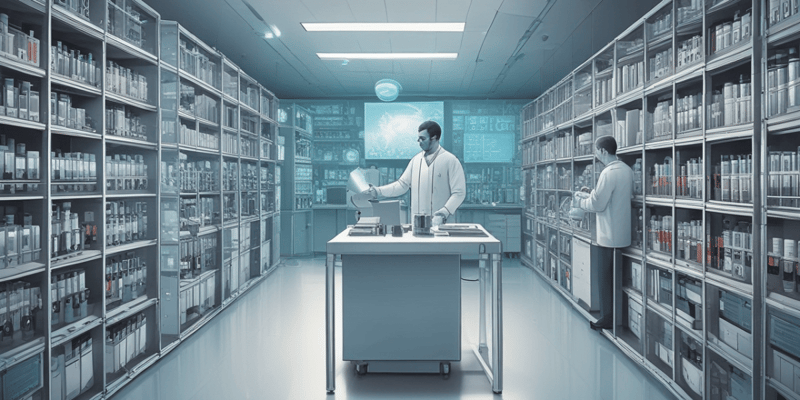Podcast
Questions and Answers
What is the primary role of computerization in the clinical laboratory?
What is the primary role of computerization in the clinical laboratory?
What type of system requires human interaction during all steps of the testing process?
What type of system requires human interaction during all steps of the testing process?
What is the benefit of using computer systems in laboratory testing?
What is the benefit of using computer systems in laboratory testing?
What information must be input into semi-automated and automated laboratory systems?
What information must be input into semi-automated and automated laboratory systems?
Signup and view all the answers
What is an example of informatics used in laboratory practice?
What is an example of informatics used in laboratory practice?
Signup and view all the answers
Why is it important for phlebotomists to be adaptable in laboratory informatics?
Why is it important for phlebotomists to be adaptable in laboratory informatics?
Signup and view all the answers
What type of system requires human intervention only when errors occur?
What type of system requires human intervention only when errors occur?
Signup and view all the answers
What is the benefit of using electronic transmission of laboratory results?
What is the benefit of using electronic transmission of laboratory results?
Signup and view all the answers
What type of system is commonly used in hospitals and mobile health units?
What type of system is commonly used in hospitals and mobile health units?
Signup and view all the answers
What is the purpose of quality checks and controls in laboratory informatics?
What is the purpose of quality checks and controls in laboratory informatics?
Signup and view all the answers
Manual systems require no human interaction during the testing process.
Manual systems require no human interaction during the testing process.
Signup and view all the answers
Semi-automated systems require human intervention only when errors occur.
Semi-automated systems require human intervention only when errors occur.
Signup and view all the answers
Computer systems can perform quality checks and controls on the input of data, even if the information is not entered correctly.
Computer systems can perform quality checks and controls on the input of data, even if the information is not entered correctly.
Signup and view all the answers
Automated systems are commonly used in hospital settings.
Automated systems are commonly used in hospital settings.
Signup and view all the answers
Phlebotomists do not need to adapt to new technologies in laboratory informatics.
Phlebotomists do not need to adapt to new technologies in laboratory informatics.
Signup and view all the answers
RFID is not an example of informatics used in laboratory practice.
RFID is not an example of informatics used in laboratory practice.
Signup and view all the answers
Semi-automated systems are not used in mobile health units.
Semi-automated systems are not used in mobile health units.
Signup and view all the answers
Insurance or billing information is not required input for semi-automated and automated laboratory systems.
Insurance or billing information is not required input for semi-automated and automated laboratory systems.
Signup and view all the answers
Manual systems are not used in provider's offices.
Manual systems are not used in provider's offices.
Signup and view all the answers
The electronic transmission of results is not an important aspect of laboratory informatics.
The electronic transmission of results is not an important aspect of laboratory informatics.
Signup and view all the answers
Study Notes
Laboratory Informatics
- Phlebotomists use technology daily to input and retrieve specimen data in clinical laboratories.
- Computerization is critical in processing, handling, and communicating laboratory processes, including POC testing, CLIA-waived test machinery, and electronic transmission of results.
Types of Computer Systems
- Manual systems: Require human interaction during pre-examination, examination, and post-examination steps in the testing process.
- Semi-automated systems: Parts of the testing process require little to no human input.
- Automated systems: Require human intervention only when errors occur.
Benefits of Informatics
- New technologies enable healthcare facilities to transition from manual to semi-automated or automated systems.
- Advantages of informatics include fewer clinical or documentation errors, timely and accurate reports, and higher quality patient care.
- Computer systems can perform quality checks and controls on data input, provided all information is entered correctly.
Essential Data for Laboratory Processing
- Patient's identification data (name, sex, date of birth)
- Ordering provider's information
- Tests ordered by the provider
- Date, time, and source of specimen collection
- Special notes, including other clinical data
- Insurance or billing information
Applications of Informatics
- Bar codes, quick response (QR) codes, and radio frequency identification (RFID) are increasingly used in practice.
Laboratory Informatics
- Phlebotomists use technology daily to input and retrieve specimen data in clinical laboratories.
- Computerization is critical in processing, handling, and communicating laboratory processes, including POC testing, CLIA-waived test machinery, and electronic transmission of results.
Types of Computer Systems
- Manual systems: Require human interaction during pre-examination, examination, and post-examination steps in the testing process.
- Semi-automated systems: Parts of the testing process require little to no human input.
- Automated systems: Require human intervention only when errors occur.
Benefits of Informatics
- New technologies enable healthcare facilities to transition from manual to semi-automated or automated systems.
- Advantages of informatics include fewer clinical or documentation errors, timely and accurate reports, and higher quality patient care.
- Computer systems can perform quality checks and controls on data input, provided all information is entered correctly.
Essential Data for Laboratory Processing
- Patient's identification data (name, sex, date of birth)
- Ordering provider's information
- Tests ordered by the provider
- Date, time, and source of specimen collection
- Special notes, including other clinical data
- Insurance or billing information
Applications of Informatics
- Bar codes, quick response (QR) codes, and radio frequency identification (RFID) are increasingly used in practice.
Studying That Suits You
Use AI to generate personalized quizzes and flashcards to suit your learning preferences.
Related Documents
Description
This quiz covers the use of technology in clinical laboratories, including data input and retrieval, processing, and communication of laboratory processes.




